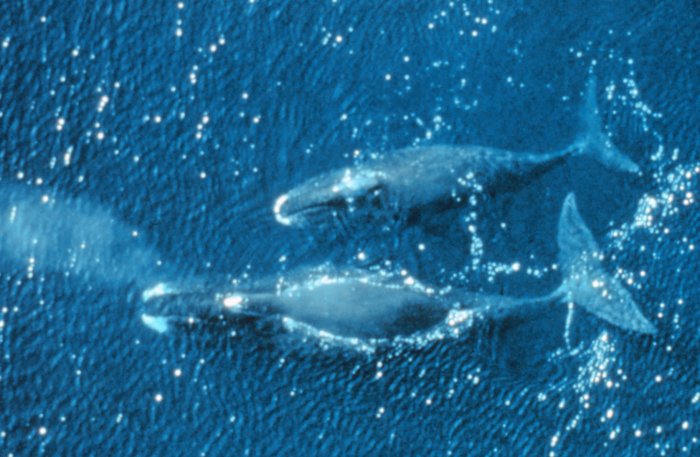
Aerial shot of bowhead whales
Bowhead whales hang out most of the year in the Arctic and don’t seem to mind dealing with sea ice at all. They have become experts at dealing with an extreme environment and are able to break through close to two feet of ice and dive up to an hour, giving them time to find openings to breath or areas to break through.
One of the heaviest animals on earth, adult bowhead whales average 46 to 59 feet and weigh 75 to 100 tons! So while bowhead whales are more than 20 feet shorter than blue whales, bowhead whales weigh almost as much. What they lack in length, they make up for in girth. This weight includes a nice layer of blubber to insulate them from crazy cold Arctic waters.
According to the Encyclopedia of Marine Mammals, the head of a bowhead whale takes up a third of the body while the tail (flukes) can reach almost 20 feet across. Bowheads are impressive animals almost any way you look at the numbers.
They have the longest baleen of any baleen whale, measuring more than three feet! The encyclopedia wagers that bowheads probably have the largest mouth of any animal. Within this mouth lurks a 16 foot long, 10 foot wide tongue that pushes out excess water to trap small crustaceans within the baleen.
Bowheads communicate with low-frequency and very loud calls, which seem to play an important role during mating. With very long life-cycles, female bowhead whales don’t reach sexual maturity until they are 15. Eye-lens analysis indicates bowheads may celebrate birthdays into the 100s! Long-lived indeed.
Based on fossil records, bowhead whales most likely hit the earth scene 8 million years ago. Thanks to whaling, bowhead whales are listed as endangered, but hopefully their many years of earth experience will see them through.
Here is an article that eastmite a population of 1,665 sperm whales in the Gulf. All of this is new to me. Interesting and disturbing, in parts. Biologists with the Minerals Management Service are attempting to identify the fish and squid species preferred by the eastmited 1,665 sperm whales that call the Gulf their home. Gulf sperm whales are genetically distinct and smaller than sperm whales found in other oceans. Research indicates that the Gulf sperm whale subspecies can sustain no more than an average 2.8 human-caused deaths each year without threatening its recovery to a non-endangered status.